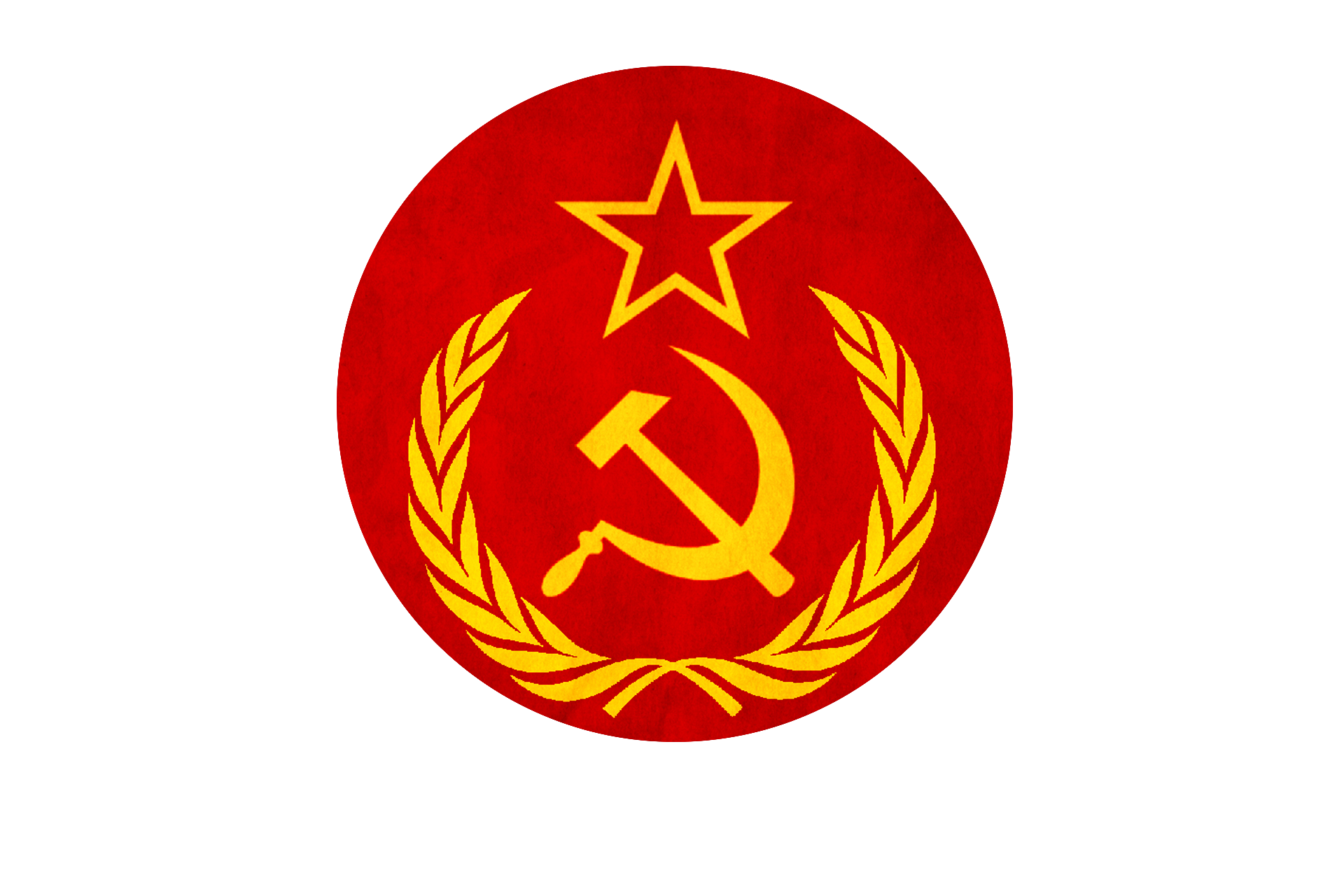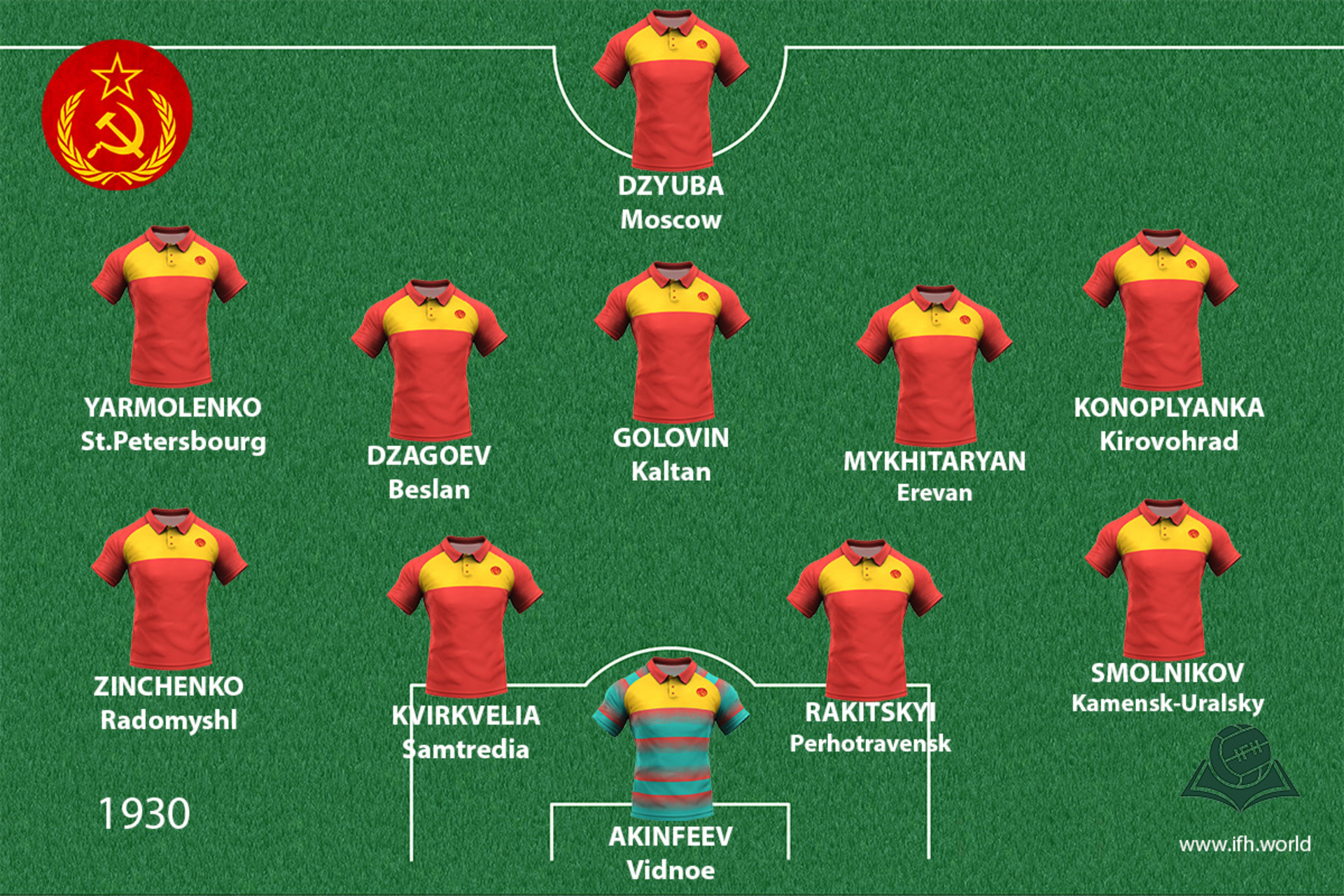Union of Soviet Socialist Republics
The communist government in Russia was established in 1917 with the October Revolution, but it stabilized only in 1922, after a victory over tsarist forces in the civil war. It was immediately followed by the proclamation of a new country – the Union of Soviet Socialist Republics.

Coat of arms
Shirt
| Position | First name | Last name | Mjesto rođenja | Like | Dislike | |
|---|---|---|---|---|---|---|
| GK | Andrey | LUNEV | Moscow |
7 |
4 |
|
| GK | Andriy | PYATOV | Kirovohrad |
3 |
2 |
|
| GK | Igor | AKINFEEV | Vidnoye |
15 |
4 |
|
| DC | Alexandr | MARTYNOVIC | Minsk |
6 |
2 |
|
| DC | Guram | KASHIA | Tbilisi |
3 |
2 |
|
| DRC | Solomon | KVIRKVELIA | Samtredia |
2 |
2 |
|
| DLC | Yaroslav | RAKITSKY | Pershotravensk |
5 |
0 |
|
| DRL/MR | Igor | SMOLNIKOV | Kamensk-Uralsky |
4 |
1 |
|
| DR | Andreas | BECK | Kemerovo |
2 |
1 |
|
| DLC/ML | Fedor | KUDRYASHOV | Irkutsk |
4 |
0 |
|
| DLC/ML | Georgi | JIKIA | Moscow |
3 |
2 |
|
| DL/ML | Georgi | SCHENNIKOV | Moscow |
6 |
4 |
|
| DC/DMC | Roman | NEUSTADTER | Dnipropetrovsk |
2 |
1 |
|
| DMC | Taras | STEPANENKO | Velyka Novosilka |
3 |
1 |
|
| MC | Aleksandr | GOLOVIN | Kaltan |
5 |
0 |
|
| MC | Aleksey | MIRANCHUK | Slavyansk-na-Kubani |
4 |
1 |
|
| MC | Pavel | MAMAEEV | Moscow |
4 |
1 |
|
| MC | Sergiy | SYDORCHUK | Zaporizhya |
2 |
0 |
|
| ML/DL | Dmitri | KOMBAROV | Moscow |
4 |
4 |
|
| MRLC | Oleg | SHATOV | Nizhny Tagil |
2 |
2 |
|
| AMC | Alan | DZAGOEV | Beslan |
3 |
0 |
|
| AMC | Henrikh | MYKHITARYAN | Erevan |
4 |
0 |
|
| AMRLC | Viktor | KOVALENKO | Kherson |
3 |
0 |
|
| AMRL | Denis | CHERYSHEV | Nizhny Novgorod |
10 |
1 |
|
| AMRL | Yehven | KONOPLYANKA | Kirovohrad |
5 |
0 |
|
| FRLC | Dmitri | POLOZ | Stavropol |
2 |
0 |
|
| FRLC | Fyodor | SMOLOV | Saratov |
4 |
1 |
|
| FC/SS | Aleksandr | KOKORIN | Valuyki |
3 |
0 |
|
| FC/SS | Artyom | DZYUBA | Moscow |
9 |
1 |
|
| AMRL/DL | Oleksandr | ZINCHENKO | Radomyshl |
19 |
1 |
Marx’s “dictatorship of the proletariat” in the USSR turned in practice into the dictatorship of the Bolshevik leadership, whose system of government was based on three basic institutions: the ruling party, the security apparatus and the military. The position of Joseph Stalin (ruled 1924 – 1953) was strengthened through the development of his leadership cult, but also through purges in political, police and military circles, mainly with accusations of acting against the country or deviation from Marx’s ideas. Different interpretations of his texts gave the authorities a lot of space to pose these accusations. Socialism in the USSR was essentially a continuation of the history of tsarist Russia, with ruthless subjugation of the population to an absolute government.
Trying to speed up the process of transformation from socialism to communism, i.e. a “higher phase”, the Party used certain measures that forced industrialization and creation of a working class, since the country was mostly agrarian. The means to implement industrialization were found in the exploitation of the village, i.e. in the methods of collectivization of agriculture and seizure of farmers’ land and properties. This policy caused the death of millions of people, mainly through famine, and the path of ultrafast economic growth of the USSR in the 1930s led them toward the top of the industrial powers of the world. They also used any means necessary to eliminate the bourgeois element from society. The ruling Party always warned this element was present and many people were executed or banished to camps that became “a necessity”.
The USSR consisted of numerous republics but it was, in fact, a centralized country. The term “soviet people” was gradually introduced, with the intent of emphasizing the advantage of unity of its citizens over national differences. The Soviet strategy is an interesting combination of russification of non-Russian peoples, but not in the name of Russian nationalism. The Russian cadre was dominant in the party’s Politburo and government apparatus, and Russian language was dominant in all schools, repressing all other national languages. However, the Russian nation was also not permitted to express national tendencies independent of official communist ideology.
In the second half of 1930s in the USSR, there is increased repression of millions of Soviet citizens that did not bypass even prominent members of the Party. This, in the end, strengthened Stalin’s absolute authority. In some places, ''cleaners'' of ''cleaners'' of ''cleaners'' were arrested. The chaos and confusion of the situation resulted in thousands being led to their death while crying their loyalty to Stalin and communism. Thousands of newly emptied places in administration created the space for the arrival of new, young and inexperienced, staff that filled the empty positions in the economy, public administration, education, etc. The new Soviet intelligentsia was raised to admire the cult of Stalin, communism and the USSR.
Sources
- Michael BURLEIGH, Treći Reich : nova povijest, Zaprešić, 2012.
- Filip ERCEG, '' O socijalizmu i komunizmu'', Čemu, 5/2003, br.11,
- Niall FERGUSON, Civilizacija: Zapad i ostali, Zagreb, 2012.
- Darko GAVRILOVIĆ, ''Komunistički mitovi: pravoslavna crkva u sovjetskom savezu i jugoslaviji kao neprijatelj i prognanik komunizma'', Mitovi epohe socijalizma (ur. Ljubiša Despotović, Darko Gavrilović, Vjekoslav Perica, Srđan Šljukić, Mitja Velikonja), Novi Sad, 2010., 71
- Jerzy HOLZER, Komunizam u Europi : povijest pokreta i sustava vlasti, Zagreb, 2002.
- Vjeran KATUNARIĆ, Sporna zajednica : novije teorije o naciji i nacionalizmu, Zagreb 2003.
- Duško SEKULIĆ, Sukobi i tolerancija : o društvenoj uvjetovanosti nacionalizma i demokracija, Zagreb, 2004.
- Robert SERVICE, Povijest suvremen Rusije, Zagreb, 2014.
- Matija Šerić ''Kada stotine tisuća nestaju: Velika česta (III.dio) .http://www.advance.hr/tekst/kada-stotine-tisuca-nestaju-sovjetska-velika-cistka-iii-dio/
- SIMONOVIĆ, ''Oktobarska revolucija: od ruševina carske Rusije do "Crvene buržoazije" '', http://www.advance.hr/vijesti/oktobarska-revolucija-od-rusevina-carske-rusije-do-crvene-burzoazije/
- Grb: http://vector.me/browse/273931/hammer_sickle_star_wreath
